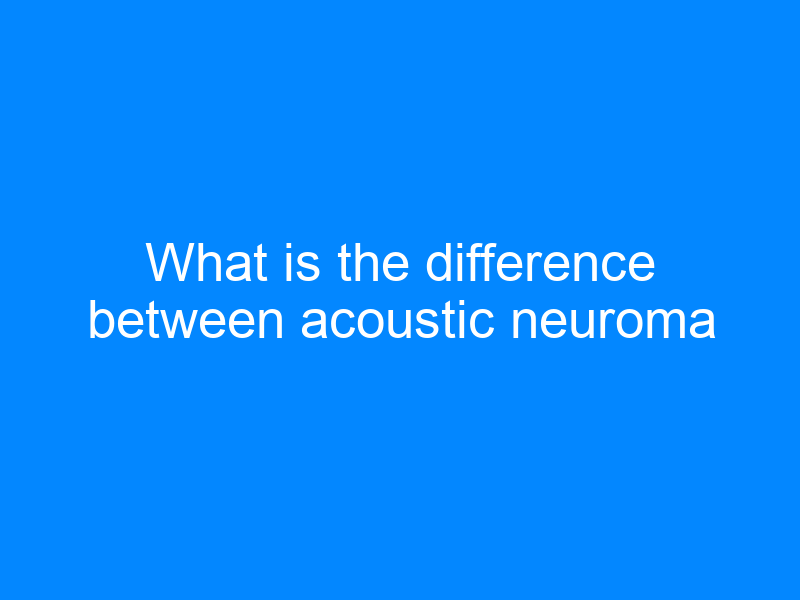Acoustic neuroma and vestibular schwannoma refer to the same vestibular disorder that causes patients to experience vertigo. Most patients suffering from acoustic neuroma are middle-aged. The only confirmed risk factor for the disorder is having a rare genetic disorder called neurofibromatosis type 2.
In this blog, we’re going to take a look at acoustic neuroma, its causes, how it is diagnosed, and the treatment process. Other names for the disorder include acoustic neurinoma, fibroblastoma, schwannoma of the acoustic nerve, and neurofibroma of the acoustic nerve.
Acoustic neuroma symptoms
Table of Contents
Acoustic neuroma symptoms will vary based on the patient’s particular case. The symptoms of the disorder appear gradually and can change as the condition gets worse. Here are some of the common symptoms:
- Hearing loss
One of the most common symptoms of acoustic neuroma is hearing loss. Initially, the hearing loss starts in one ear, and in most cases, the symptom appears gradually over time.
- Tinnitus
Along with hearing loss, tinnitus is another common symptom experienced by patients suffering from an acoustic neuroma. A patient experiencing tinnitus will experience a false sensation of ringing in the ear.
- Vertigo and Dizziness
After hearing loss and tinnitus, vertigo and balancing problems are other symptoms that can be caused by vestibular schwannoma. In some very rare cases, patients can experience symptoms and type of vertigo and dizziness before experiencing hearing loss and tinnitus.
- Nervous system problems
While it is pretty rare, vestibular schwannoma can also cause problems with the nervous system such as hydrocephalus, facial weakness or paralysis, facial tingling or numbness, and more.
It is also possible for patients suffering from vestibular schwannoma to not experience any symptoms, especially if they are in the early stages of the condition.
Acoustic neuroma causes
An acoustic neuroma or a vestibular schwannoma is a slowly-growing tumor on the eighth cranial nerve, which runs from the inner ear to the brain. This nerve is responsible for maintaining balance and hearing.
Depending on the size and the location of the tumor, the patient can experience different symptoms. As the tumor grows, the symptoms get more problematic. In extremely rare cases, vestibular schwannoma can cause life-threatening complications. As of date, the exact cause of a vestibular schwannoma is not known. Research is still on-going but there are no confirmed answers at the moment.
However, there are some risk factors that are considered to play a part in causing vestibular schwannoma such as:
- Radiation exposure to the head and neck area
- Prolonged exposure to loud noises
- Genetic disorders such as neurofibromatosis type II
Acoustic neuroma diagnosis
the diagnosis for vestibular schwannoma involves clinical evaluation and detailed patient history is taken into consideration. Additionally, a variety of tests are also conducted to diagnose the disorder. Tests for diagnosing vestibular schwannoma include hearing exams, magnetic resonance imaging (MRI), and computed tomography (CT).
These tests help in identifying different aspects of the patient’s condition and are used to check for symptoms like nystagmus and the hearing and neurological function and interactions in the patients. Tests like these are also part of vertigo treatment in general and are used to identify the actual cause of vertigo in the patient.
Acoustic neuroma treatment
when it comes to treatment for vestibular schwannoma, there are mainly three options – observation, surgery, and radiation therapy.
In case the tumor is small and is not causing symptoms, observation is usually the preferred option. In case the tumor is large and growing, surgery and radiation can be used to provide treatment to the patient.
- Observation
If the tumor is small or if the patient is elderly, observation is often the approach adopted by medical professionals. Since the tumors are slow-growing, they can take a long time before causing any serious health effects.
Other treatment options like surgery and radiation can have side effects and they are usually avoided if possible.
- Surgery
In some cases, the doctor might feel that surgery is the best option for the patient. The surgery to remove vestibular schwannomas is performed with specialized instruments that help the doctors perform the surgery precisely on very small body parts. During the surgery, the tumor is removed either completely or partially depending on the particular condition of the tumor.
- Radiation Therapy
Other than surgery, radiation therapy can also be used to reduce the size of the tumor without damaging the cells around it. Radiation therapy can be delivered on an out-patient basis or over multiple sessions. As opposed to surgery, it is a non-invasive treatment method. Vestibular schwannoma is rare and mostly treatable
Vestibular schwannoma is a very rare disorder. If you’re experiencing vertigo, there is a higher chance that you might be suffering from some other condition. However, it might be a good idea to visit your regular ENT specialist to ensure you stay safe and healthy.
Keep reading this blog to learn more about vertigo medicine and treatment.




